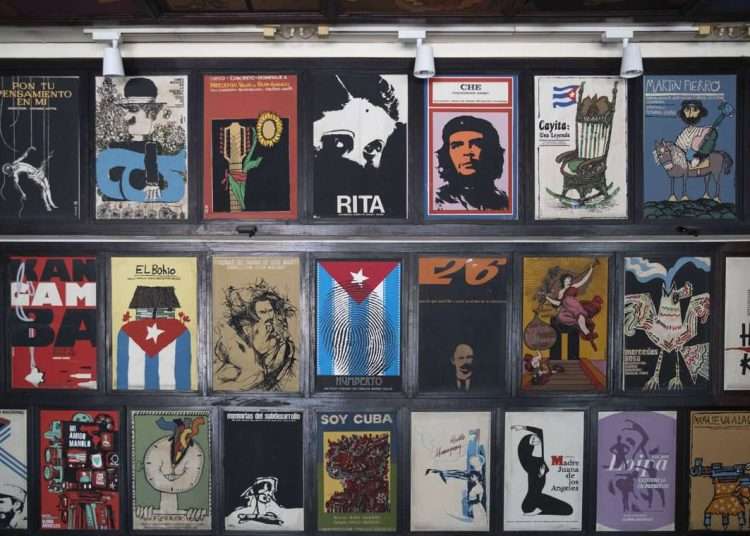The Cuban movie posters have just been registered as a Documentary World Heritage by UNESCO, thus giving recognition to its designers and visibility to a hidden gem of the island’s art of the last decades.
“Expected and deserved,” this is how the director and representative of the regional office for Culture in Latin America and the Caribbean of the United Nations Educational, Scientific and Cultural Organization (UNESCO), Anne Lemaistre, sees it. She explained in an interview with EFE that this program “advocates for the conservation of audiovisual heritage, which is also the collective memory of the world.”
The presence of this Cuban collection in the international Memory of the World register is, for Lemaistre, a recognition of the “great creative originality found in these posters, the graphic beauty and the communicative effectiveness of these documents.”
She recalls that since 1992 — when this category of registration that includes audiovisuals and manuscripts was created — 430 world heritage works have been registered.
From Cuba, the writings of nation hero José Martí Foundation have also been included; as well as the negatives of the newscast from the Cuban Institute of Cinematographic Art and Industry (ICAIC) and original manuscripts of the Argentine-Cuban guerrilla Ernesto “Che” Guevara, including his campaign diary in Bolivia.
Lemaistre highlighted the “immense” and “very special” talent of Cuban designers, who “with few means, but with the technique of silk screen printing, managed to encapsulate — with some colors and a very affirmed design — the essence of a film” with “great visual impact.”
“I think these posters give Cuba great visibility, it is an image of Cuba among others and a visual education tool for an entire Cuban generation,” she said.
Visible heritage
Along the same lines, Sara Vega, a specialist in graphics from the Cuban Cinematheque and in charge of the almost 3,000 pieces that make up the collection, is pleased for having contributed to “this being digitized, preserved and having this result at an international level.”
In addition to protecting and studying the Cuban movie poster, Vega explained to EFE that her fundamental task is to expose the collection to the public eye because “heritage that is not made visible is as if it did not exist.”
And, in particular, she attaches great importance to making these pieces available to “the younger people, an emerging audience, designers and students who need these references to move forward” in the visual arts on the island.
Its declaration as a World Heritage is “super important” because it recognizes the admirable work of many designers who intervened in the promotion of both Cuban and foreign cinema as well as its festivals, retrospectives and exhibitions.
The first poster
Vega recalls the history of Cuban movie posters after the creation of ICAIC in 1959 — with the triumph of the revolution —, when it was decided that the films to be shown in Cuba — both national and foreign — would be accompanied by a poster.
The Cuban film Historias de la revolución, directed by Tomás Gutiérrez Alea, released in 1960, was the first fiction feature film made by ICAIC and the one that premiered the poster created by designer Eduardo Muñoz Bachs.
Then the offset printing technique was changed to silk screen printing and the movie poster format would be standard. The designers, who came from advertising or the plastic arts, turned to create with symbols and metaphors, interpreting the theme of the film.
“In other words, movies took to the streets and brought the public into the theaters based on the actions of these designers with their posters,” the specialist said.

Among many of its creators, Vega cited the Cubans Rafael Morante, René Azcuy, Alfredo Rostgaard, Antonio Pérez (Ñiko), the painters Servando Cabrera and Raúl Martínez, as well as the Chilean Roberto Matta and the Spanish Antonio Saura, among others.
They appropriated the essence of films like Besos Robados, Lucía, Memorias del Subdesarrollo, Fresa y chocolate, La última cena, La bella del Alhambra and Sacco y Vanzetti to accompany their promotion on the island with the graphics.
Reproductions of this collection of film posters have covered the walls and ceiling of the lobby of the ICAIC headquarters in Havana for years, a space that Vega sees as a permanent exhibition gallery.
The set of film posters and the capitular minutes of the Havana City Hall (1550-1898) rose to the international level of the Memory of the World program on May 18, during the meeting of the UNESCO Executive Council.
The capitular minutes, belonging to the Office of the Havana Historian, are gathered in 273 books, among them 200 originals, among which are drafts, resolutions and agreements made by the city hall of the Cuban capital from the 16th to the 18th century.
Raquel Martori/EFE











Please what is the official date of the entry into the unesco list was it on or before this article ?